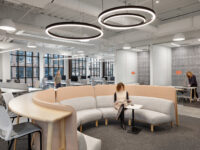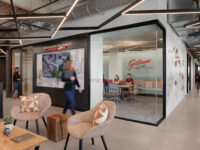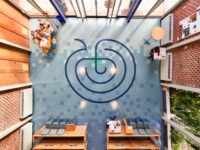The healthcare environment continues to be pushed in new directions for a variety of reasons, ranging from technological improvements, labor shortages, and operational efficiencies. Here are 9 trends shaping the healthcare industry, and ultimately shaping the way we design, interact, and utilize these care spaces.
Caregiver Customization
Our first healthcare design trend is making the caregiver’s comfort a priority. Let caregivers determine the most comfortable atmosphere conducive to healing by giving them the tools to do so. These new caregiver controls let healthcare workers choose between warm and cool lighting, adjust the climate, and have more input and control over the decor and look of the environment. Advanced interfaces are becoming more streamlined and affordable for healthcare facilities to implement, which will only boost the popularity of these systems.
Increased Competition from Labor Shortages
The ongoing labor shortage in healthcare will push organizations to rethink how they attract and retain caregivers. Beyond traditional recruitment, healthcare facilities need to create mission-driven brands and design inviting spaces that make caregivers want to stay. A well-designed workplace—including comfortable furniture and thoughtful layouts—can play a big role in boosting staff satisfaction.
Human-Focused Technologies
Designing with the end-user in mind means incorporating technology that simplifies both caregiver and patient experiences. Innovations like digital checkpoints, smart signage for staff communication, and patient-facing interactive screens are becoming more common. These tech upgrades blend seamlessly with existing infrastructures, making healthcare spaces more efficient and patient-friendly.
Inviting, Hospitable Environments
Healthcare spaces are stepping away from the cold, sterile designs of the past and embracing a warmer, more inviting aesthetic. Natural elements, comfortable seating, and a broader range of colors are helping to create spaces that feel welcoming while still maintaining cleanliness. Sterility doesn’t have to mean a stark, clinical appearance.
Zen Dens
With mental health taking center stage, many facilities are introducing “Zen Dens”—calm, relaxing spaces separate from traditional break rooms. These areas provide healthcare staff with a quiet place to decompress, reducing stress and helping them recharge during their shifts.
Increased Specialization
As technology and patient demands change, so do our facilities. Recently, more procedures have moved to out-of-hospital care settings such as specialty clinics and surgery centers. This change opens up design possibilities in hospitals that previously had rooms dedicated to procedures they no longer do in-house. In addition, these out-of-hospital facilities need specialized design, unique to the procedures and demand.
Artificial Intelligence and Healthcare
As is in many industries, artificial intelligence (AI) tools are on the fast track to improved communication, coordination, and collaboration. AI tools can process conversations and in real time invite input from team members and the patient. These tools can also identify relevant clinicians outside the immediate team to bring their expertise into the decision-making process.
On the Go Treatment
Mobile medical carts are becoming a staple in healthcare environments. Equipped with touchscreens, RFID technology, and wireless communication, these carts allow caregivers to work from anywhere, improving access to data, medication management, and communication on the move.
Modularity
To address capacity challenges, many health systems are turning to modular construction. This involves building repetitive sections off-site, transporting them, and assembling them on-site. Modular design helps save time, reduce costs, and improve overall quality, making it an increasingly popular option for new healthcare facilities.
Stay Ahead of The Curve
At King Business Interiors, we monitor the healthcare industry continuously to identify key ways to improve the design and functionality of key care spaces. Consult with one of our designers to see how we can use furniture to create design solutions that benefit both the patient and the caregiver.



